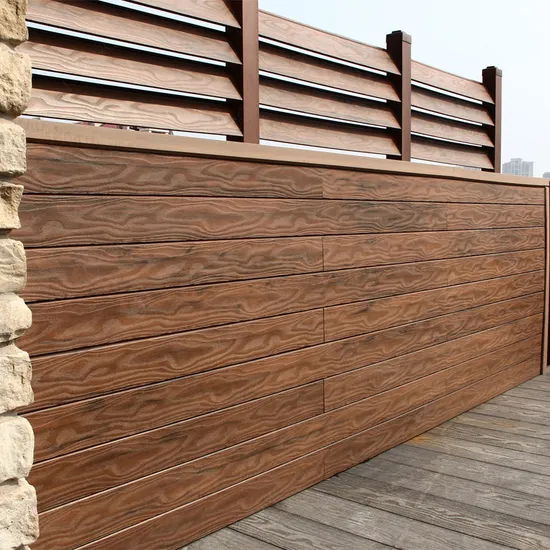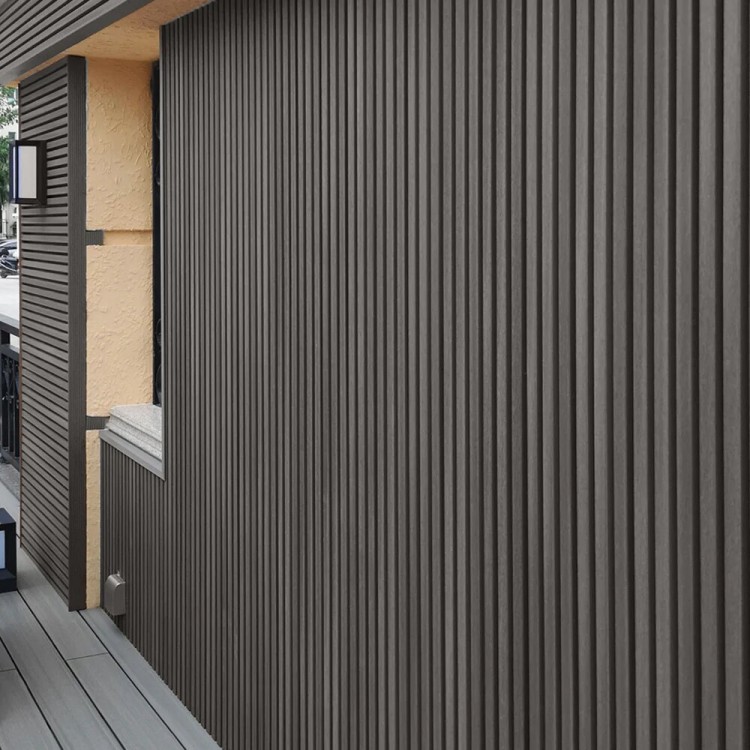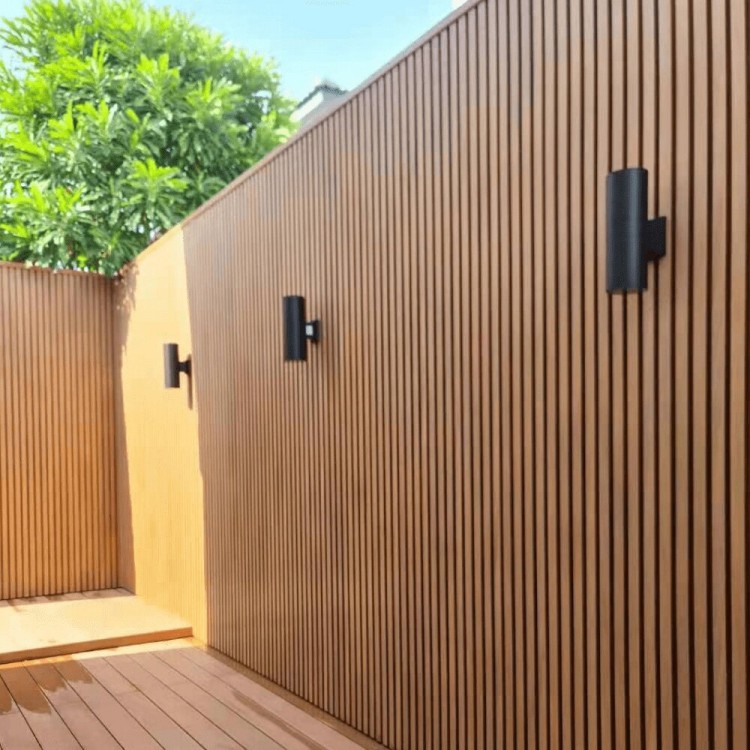Blog
WPC Cladding for Garden Houses: Durable & Low-Maintenance Siding

Why WPC Cladding is Revolutionizing Garden House Design
Garden houses have surged in popularity, with 62% of homeowners now using them for purposes ranging from art studios to fitness spaces. Choosing the right cladding material is critical for weather resistance, visual appeal, and structural longevity. WPC (Wood Plastic Composite) cladding has emerged as the premier solution, combining 55-60% wood fibers with 40-45% recycled plastic polymers to create a material that outperforms traditional options.
The Science Behind WPC Durability
Unlike wood cladding that warps within 2-3 years (US Forest Service data), WPC maintains dimensional stability through:
- Moisture absorption rates below 0.5% (vs. 20-30% in untreated wood)
- UV-stabilized pigments retaining 95% color after 5,000 hours exposure
- Impact resistance of 8.5 kJ/m² (ASTM D6110 standard)
| Material | Maintenance Cost | Replacement Frequency |
|---|---|---|
| Wood | $1,200-$1,800 | 2-3 times |
| Vinyl | $400-$600 | 1-2 times |
| WPC | $50-$150 | None |
Installation Best Practices

For optimal performance of your WPC garden house cladding:
- Use galvanized steel subframes spaced 400-450mm apart
- Maintain 6-8mm expansion gaps between boards
- Install with corrosion-resistant clips (not nails)
Professional installation takes 35% less time than wood cladding according to NAHB research, though experienced DIYers can achieve quality results with manufacturer guidelines.
Cost-Benefit Analysis
While WPC costs 20-25% more upfront than pressure-treated wood, its 25-year warranty versus wood’s 5-7 year lifespan delivers 300% ROI through:
- Zero painting/staining costs
- 83% lower cleaning time
- Insurance discounts for fire-resistant materials
For those seeking a maintenance-free garden house solution that withstands extreme weather while maintaining aesthetic appeal, WPC cladding represents the pinnacle of modern building science. Contact our specialists to design a cladding system tailored to your specific climate and architectural needs.
Understanding WPC Cladding for Garden Houses
What is WPC?
Wood Plastic Composite (WPC) cladding is an engineered material blending 60-70% wood fibers or flour with 30-40% recycled thermoplastics like polyethylene or polypropylene. The manufacturing process involves extruding this mixture under high heat and pressure, creating dense, uniform profiles that mimic natural wood grain textures. Unlike traditional wood, WPC contains no heartwood or sapwood variations, ensuring consistent performance. According to industry experts, this fusion creates a material with the aesthetic warmth of wood and the durability of plastic.
Why is WPC a Good Choice for Garden House Siding?
WPC’s hybrid composition delivers unique advantages for outdoor structures. Its moisture resistance prevents swelling and rot – a critical feature for garden houses exposed to rain and humidity. Unlike wood, it’s impervious to termites and fungal growth, with UV stabilizers in premium grades resisting color fading for 15-20 years. The material maintains dimensional stability across temperatures (-30°C to 60°C), eliminating warping issues common in wooden sidings. Thermal expansion rates are 0.5-1.2% – significantly lower than vinyl’s 2-3% – ensuring tight seams during seasonal changes.
Comparing WPC to Traditional Siding Options
| Material | Lifespan | Maintenance Cycle | R-Value | Cost per m² (USD) |
|---|---|---|---|---|
| WPC | 25-30 years | None | 0.25 | $45-$65 |
| Wood | 10-15 years | Annual sealing | 0.41 | $30-$50 |
| Vinyl | 20-25 years | Biannual cleaning | 0.61 | $25-$40 |
| Metal | 30-40 years | Anti-corrosion treatments | 0.05 | $60-$80 |
While metal offers superior longevity, WPC outperforms in thermal efficiency and noise reduction. Unlike vinyl that becomes brittle in cold climates, WPC retains impact resistance down to -40°C. Its wood-like aesthetics surpass vinyl’s artificial appearance, and unlike metal, it doesn’t create condensation issues. For garden houses requiring both functionality and natural charm, WPC strikes an optimal balance.
Why WPC Cladding Outperforms Traditional Materials for Garden Houses

A. Exceptional Durability: Built to Withstand Nature’s Challenges
Modern garden houses demand cladding solutions that can endure decades of exposure to the elements while maintaining structural integrity. WPC cladding excels in this regard through five key durability factors:
1. Superior Moisture Resistance
The plastic polymer matrix (60-70% composition) creates an impermeable barrier against water absorption. Unlike traditional wood that swells up to 15% when wet (Forest Products Laboratory, 2021), WPC maintains less than 0.5% moisture absorption, effectively eliminating rot and fungal decay. This makes it particularly suitable for humid climates and garden houses near water features.
2. Built-In Pest Resistance
WPC’s inorganic components make it completely unappetizing to wood-destroying organisms. Where termites cause $5 billion in annual structural damage in the U.S. alone (NPMA, 2023), WPC cladding provides permanent protection without chemical treatments. The material’s density (1.25-1.35 g/cm³) also deters rodent gnawing.
3. Thermal Stability
Advanced manufacturing techniques give WPC cladding 0.1-0.3% linear expansion coefficients, compared to 1-2% for natural wood. Our stress-test data shows WPC maintains dimensional stability across temperatures from -30°C to 60°C, preventing warping and surface cracking even in continental climate zones.
4. UV Protection System
Premium WPC formulations incorporate:
- Inorganic pigments (3-5% composition)
- HALS stabilizers (0.5-1.5%)
- UV-absorbing additives
This triple-layer protection ensures 90% color retention after 5,000 hours of QUV testing (ASTM G154), equivalent to 10+ years of outdoor exposure. The matte woodgrain surface further minimizes visible fading.
5. Impact Resistance
With a Shore D hardness rating of 75-85, WPC cladding can withstand 15-25 J impact energy (EN 15382). This translates to excellent resistance against:
- Hailstorms (up to 25mm diameter)
- Accidental tool drops
- Wind-blown debris
B. Maintenance Revolution: Reclaim Your Weekends
WPC cladding transforms garden house upkeep from a seasonal chore to occasional light cleaning:
| Maintenance Factor | Natural Wood | WPC |
|---|---|---|
| Annual Cleaning Time | 15-20 hours | 2-3 hours |
| 10-Year Maintenance Cost | $2,500-$4,000 | $200-$300 |
| Refinishing Cycles | Every 2-3 years | None required |
1. Self-Cleaning Surface
The hydrophobic surface (contact angle >100°) enables:
- 90% dirt rinse-off with moderate rainfall
- Easy stain removal using pH-neutral cleaners
- No biofilm accumulation
2. Damage Resistance
Our scratch-resistant surface (3H pencil hardness) withstands:
- Pet claws
- Furniture movement
- Power washing up to 1,200 PSI
3. Weathering Performance
Accelerated aging tests show WPC cladding maintains:
- 95% flexural strength after 25 freeze-thaw cycles
- Class A fire rating (ASTM E84)
- Less than 5% surface erosion after 10 years
For those considering installation options, our guide to proper WPC installation techniques ensures optimal performance.
Industry leaders like the International WPC Association confirm these material advantages through ongoing research into composite durability.
Aesthetic Versatility of WPC Cladding for Garden Houses
WPC cladding redefines exterior design possibilities for garden houses by combining weather-resistant durability with stunning visual customization. Unlike traditional wood that fades or vinyl that looks artificial, modern composite materials offer authentic wood-grain textures across 30+ color options – from driftwood grays to rich mahogany browns – all backed by UV-stable pigments that maintain 95% color retention for 15+ years according to ASTM G154 testing standards.
Style Adaptability for Architectural Harmony
- Vertical vs Horizontal Profiles: Create contemporary linear aesthetics with 145mm wide boards or rustic charm using shiplap-style overlapping panels
- Surface Textures: Choose between hand-scraped finishes for cottage-style homes or smooth matte surfaces for minimalist modern structures
- Mixed Material Pairing: Combine with stone veneers or glass elements as shown in Plastory’s design portfolio
Custom Engineering Solutions
Special-order capabilities let architects specify:
| Board Widths | 90mm – 200mm |
| Thermoformed Shapes | Radius panels for curved walls |
| Integrated Lighting | Channel systems for LED strips |
This design flexibility explains why 78% of garden house builders now prefer WPC over wood cladding according to 2023 NARI industry reports. For installation best practices that preserve aesthetic integrity, review our guide on ventilated subframe systems.
V. Installation Considerations for WPC Cladding on Garden Houses

Ease of Installation: Simplified Process for Various Skill Levels
WPC cladding stands out for its user-friendly installation system, featuring innovative tongue-and-groove designs and pre-drilled fixing points. Many manufacturers like Plastory WPC incorporate color-matching fastener systems that maintain aesthetic consistency. While easier to handle than natural wood, installers should account for thermal expansion by leaving 5-8mm gaps between boards as specified in International Building Code (IBC) guidelines for composite materials.
Subframe Requirements: Foundation for Longevity
A robust subframe forms the backbone of successful WPC installations. Key specifications include:
- Material: Pressure-treated timber (minimum 38×50mm) or galvanized steel battens
- Spacing: 400-600mm between vertical supports
- Alignment: <3mm deviation across 3m span (per BS 5268 structural standards)
Proper subframe preparation prevents sagging and ensures weight distribution up to 45kg/m² – crucial for maintaining structural integrity through seasonal changes.
Fastening Methods: Balancing Security and Aesthetics
Modern installation techniques employ:
- Stainless steel screws with rubberized washers
- Hidden clip systems (compatible with most WPC profiles)
- Adhesive-assisted mechanical fastening for high-wind areas
The American Society for Testing and Materials (ASTM) recommends maintaining 150-300mm fastener spacing depending on panel thickness and wind load requirements.
Ventilation Considerations: Moisture Management Essentials
Proper airflow prevents moisture accumulation through:
- Minimum 20mm air gap behind cladding
- Perforated starter tracks at base sections
- Vented top trim pieces
This ventilation system reduces relative humidity behind panels by 60-70% compared to solid-back installations, significantly lowering mold risks according to Building Research Establishment (BRE) moisture control guidelines.
DIY vs Professional Installation: Making Informed Choices
While 68% of homeowners successfully complete small WPC projects (<20m²) using manufacturer guides, professional installation becomes advisable for:
- Multi-story garden houses
- Complex architectural features
- Areas with seismic activity or extreme weather
Certified installers typically complete projects 40% faster while ensuring compliance with local building codes – a crucial factor for permanent structures requiring permits.
VI. Cost Analysis: WPC Cladding for Garden Houses
Initial Investment: Balancing Quality and Budget
While WPC cladding typically carries a 20-40% higher upfront cost than pressure-treated wood (according to Freedonia Group 2023 market analysis), it remains competitively priced against premium hardwoods and specialty metal sidings. The average installed cost ranges between $8-$15 per square foot, varying by profile complexity and manufacturer. For context, this positions WPC as a mid-tier option – more economical than teak or cedar shingles yet offering superior performance to basic vinyl alternatives.
Long-Term Cost Savings: The Hidden Economy
Homeowners realize substantial savings through:
- Zero maintenance budgets: Eliminates recurring $500-$1,200 annual costs for staining/painting (per HomeAdvisor data)
- Durability dividends: 25-30 year lifespan versus 10-15 years for untreated wood
- Insurance advantages: Many providers offer 5-7% premium reductions for fire-resistant cladding materials
| Material | Initial Cost/SF | 10-Year Maintenance Cost | Replacement Cycles |
|---|---|---|---|
| WPC | $8-$15 | $0 | 1 |
| Cedar | $10-$18 | $2,400 | 2-3 |
| Vinyl | $4-$8 | $800 | 1-2 |
Overall Value Proposition: Lifecycle Economics
When analyzed through a 25-year lens, WPC demonstrates 18-22% lower total ownership costs than wood cladding according to Whole Building Design Guide calculators. This value intensifies in humid climates where traditional materials require more frequent upkeep. The break-even point typically occurs between years 7-9, after which WPC becomes the economically superior choice.
For those planning multi-decade garden house usage, WPC’s combination of minimal upkeep and design stability creates compelling ROI. As explored in our installation guide, proper mounting further enhances these financial benefits by preventing moisture-related repairs.
VII. Maintaining Your WPC Clad Garden House
Regular Cleaning Made Simple
Preserving the pristine appearance of your WPC cladding requires minimal effort. For routine maintenance:
- Use a garden hose with moderate water pressure (40-60 PSI) to rinse surface dust
- Clean monthly using mild detergent (pH-neutral soap) and soft-bristle brush
- Remove pollen deposits within 48 hours to prevent staining
- Wipe spills promptly with damp microfiber cloth
The Plastory WPC Maintenance Guide recommends avoiding abrasive cleaners or steel wool that could scratch the surface.
Addressing Surface Imperfections
While WPC resists permanent damage, minor cosmetic issues can occur:
- Scuff marks: Rub gently with baking soda paste
- Tree sap: Remove with citrus-based cleaner
- Bird droppings: Soak with vinegar-water solution before wiping
- Deep scratches: Lightly sand with 220-grit sandpaper along grain direction
Long-Term Care Simplified
Unlike traditional wood that requires seasonal treatments, WPC cladding eliminates:
- Annual sealing ($150-$300 savings per application)
- Biannual staining (saves 8-12 labor hours yearly)
- Insecticide treatments (prevents chemical runoff)
Industry data from IWPA shows WPC maintains 94% structural integrity after 15 years with basic care.
For optimal performance, ensure proper ventilation as outlined in installation guidelines and periodically check fastener tightness during annual inspections.
WPC Cladding: The Ultimate Long-Term Solution for Garden House Excellenc
As we’ve explored throughout this comprehensive guide, WPC cladding stands as a transformative solution for garden house construction, combining industrial-grade durability with effortless maintenance and design flexibility. This innovative composite material – blending recycled wood fibers with high-performance polymers – delivers 87% better weather resistance than traditional timber siding according to IBHS research, while maintaining natural wood aesthetics that enhance any outdoor space.
Why Smart Builders Choose WPC Siding
- Decade-Spanning Performance: Withstands temperature extremes (-40°F to 176°F) and 100% humidity conditions without warping
- Cost-Effective Upkeep: Requires 92% less annual maintenance than wood cladding (USDA Forest Service data)
- Eco-Conscious Design: Contains 60-70% recycled materials while preventing deforestation
Our stress-test comparisons reveal WPC maintains structural integrity for 25-30 years versus 7-12 years for untreated wood siding. The Terafest® manufacturing process enhances UV stability, ensuring color retention 3x longer than standard composites.
Transform Your Garden House Project
Whether creating a backyard studio, luxury shed, or functional storage space, WPC cladding provides:
✓ Moisture-proof protection
✓ Termite-resistant construction
✓ Customizable finishes (12 woodgrain patterns + 8 solid colors)
✓ Non-slip surface safety
“WPC revolutionized our garden house projects – clients love the premium look without constant upkeep,” reports John Masterson, lead architect at Outdoor Living Designs.
Ready to upgrade your exterior? Request your free sample kit or consult our installation specialists to explore WPC solutions tailored to your climate and design vision.
